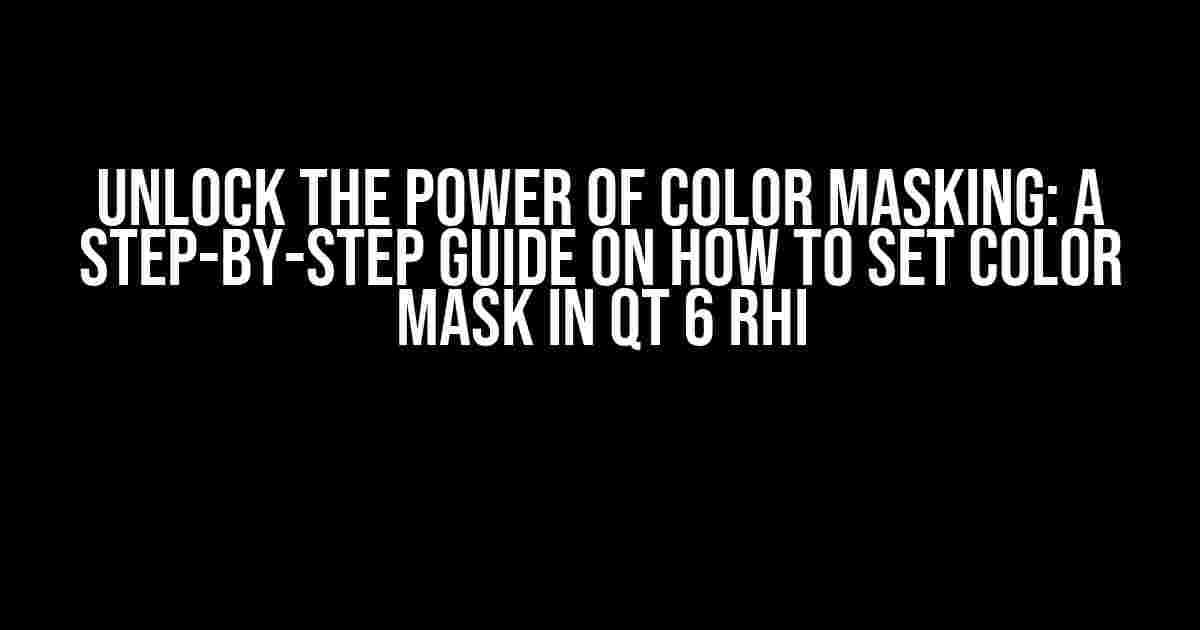Are you tired of bland and uninspiring visuals in your Qt applications? Do you want to take your graphics to the next level by adding a touch of creativity and flair? Look no further! In this comprehensive guide, we’ll dive into the world of color masking and explore how to set color mask in Qt 6 RHI.
What is Color Masking?
Color masking is a technique used in computer graphics to selectively apply colors to specific parts of an image or 3D model. By controlling the color output, you can create stunning visual effects, such as highlighting, glow, or even entire color grading schemes. In the context of Qt 6 RHI, color masking allows you to manipulate the rendering pipeline to produce striking visuals that captivate your users.
Why Use Color Masking in Qt 6 RHI?
- Enhanced Visuals**: Color masking enables you to add depth, contrast, and vibrancy to your graphics, making your application stand out from the crowd.
- Flexibility and Control**: With color masking, you have precise control over the rendering process, allowing you to fine-tune your visuals to achieve the desired look and feel.
- Improved Performance**: By leveraging the power of Qt 6 RHI’s rendering pipeline, color masking can be performed efficiently, without sacrificing performance.
Setting Up Qt 6 RHI for Color Masking
Before we dive into the meat of color masking, let’s ensure you have Qt 6 RHI set up and ready to go. If you’re new to Qt, don’t worry – we’ll guide you through the process!
- Install Qt 6**: Download and install Qt 6 from the official Qt website. Make sure to choose the correct version for your system architecture.
- Create a New Qt Project**: Fire up Qt Creator and create a new Qt Widgets Application project. Name it, for example, “ColorMaskingDemo”.
- Configure Qt 6 RHI**: In your project’s .pro file, add the following lines to enable Qt 6 RHI:
rendertype = rhi QT += rhi
The Anatomy of a Color Mask
To set a color mask in Qt 6 RHI, you’ll need to understand the underlying components. A color mask typically consists of:
| Component | Description |
|---|---|
| Mask Texture | A 2D texture that defines the color mask patterns |
| Mask Shader | A custom shader program that applies the mask texture to the rendered image |
| Render Pass | A Qt 6 RHI render pass that executes the mask shader and blends the masked color with the original image |
Creating a Mask Texture
A mask texture is a grayscale image that defines the color mask pattern. You can create a mask texture using your favorite image editing software or generate one programmatically. For this example, let’s create a simple radial gradient mask.
// radial_gradient_mask.png (256x256) // Top-left corner (white) // Top-right corner (black) // Bottom-left corner (black) // Bottom-right corner (white) // Gradually transition from white to black
Writing a Mask Shader
The mask shader is responsible for applying the mask texture to the rendered image. Create a new file, `mask_shader.frag`, and add the following code:
#version 460 core
in vec2 texCoord;
out vec4fragColor;
uniform sampler2D maskTexture;
uniform vec4 maskColor;
void main() {
vec4 textureColor = texture(maskTexture, texCoord);
vec4 maskedColor = textureColor * maskColor;
fragColor = maskedColor;
}
This shader multiplies the mask texture’s alpha value with the mask color, effectively applying the mask pattern to the rendered image.
Setting Up the Render Pass
Create a new file, `color_masking.cpp`, and add the following code:
#include <QWindow>
#include <QRhi>
#include <QRhiShaderResourceBindings>
#include <QRhiRenderPassDescriptor>
#include <QRhiTexture>
// ...
QRhi* rhi = QRhi::create();
// Load the mask texture
QRhiTexture* maskTexture = rhi->newTexture(QRhiTexture::RGBA8, 256, 256);
maskTexture->setData("radial_gradient_mask.png");
// Create a new render pass descriptor
QRhiRenderPassDescriptor* renderPassDesc = new QRhiRenderPassDescriptor();
// Set the mask shader and bindings
renderPassDesc->setShader(":/mask_shader.frag");
QRhiShaderResourceBindings* bindings = new QRhiShaderResourceBindings();
bindings->setBindings({
{ "maskTexture", maskTexture },
{ "maskColor", QRhiVertexInputAttribute::create("maskColor", QRhiVertexInputAttribute::Float4) }
});
renderPassDesc->setShaderResourceBindings(bindings);
// Create a new render pass
QRhiRenderPass* renderPass = rhi->newRenderPass(renderPassDesc);
// ...
// Use the render pass in your Qt 6 RHI rendering pipeline
Putting it All Together
Now that you have the mask texture, shader, and render pass set up, it’s time to integrate them into your Qt 6 RHI application. Update your main.cpp file to include the following code:
int main(int argc, char* argv[]) {
QCoreApplication app(argc, argv);
// ...
// Create a new Qt 6 RHI window
QWindow window;
window.resize(1024, 768);
window.show();
// Initialize the rendering pipeline
// ...
// Set the color mask render pass
window->setColorMaskRenderPass(renderPass);
// Start the rendering loop
// ...
return app.exec();
}
Conclusion
Congratulations! You’ve successfully set up a color mask in Qt 6 RHI. With this powerful technique, you can unlock a world of creative possibilities and take your graphics to the next level. Remember to experiment with different mask textures, shaders, and render passes to achieve unique visual effects.
By following this comprehensive guide, you’ve gained a solid understanding of the principles behind color masking and how to implement it in Qt 6 RHI. Don’t be afraid to push the boundaries of what’s possible – the world of computer graphics is full of endless possibilities!
Additional Resources
Frequently Asked Question
Get ready to unlock the secrets of setting color masks in Qt 6 RHI!
What is a color mask and why do I need it in Qt 6 RHI?
A color mask is a bitmask that determines which color channels (red, green, blue, and alpha) are written to the framebuffer. You need it in Qt 6 RHI to control how colors are written to the screen, allowing for advanced effects like alpha blending and color keying.
How do I set a color mask in Qt 6 RHI?
You can set a color mask in Qt 6 RHI by creating a QColorMask object and passing it to the QRhiGraphicsPipeline::setColorMask() function. For example, `QRhiGraphicsPipeline *pipeline; QColorMask colorMask = QRhiColorMask(RGBA_Mask); pipeline->setColorMask(colorMask);`
What are the different types of color masks available in Qt 6 RHI?
Qt 6 RHI provides several types of color masks, including RGBA_Mask (writes to all channels), RGB_Mask (writes to red, green, and blue channels), and Alpha_Mask (writes only to the alpha channel). You can combine these masks to create a custom color mask that suits your needs.
Can I change the color mask during rendering in Qt 6 RHI?
Yes, you can change the color mask during rendering by calling QRhiCommandBuffer::setColorMask() between QRhiCommandBuffer::beginPass() and QRhiCommandBuffer::endPass(). This allows you to dynamically adjust the color mask based on your rendering needs.
Are there any performance considerations when using color masks in Qt 6 RHI?
Yes, using color masks can impact performance, especially when changing the mask frequently. Minimize mask changes and use QRhiCommandBuffer::setColorMask() judiciously to maintain optimal performance. Additionally, consider using a QRhiGraphicsPipeline cache to reduce the overhead of pipeline state changes.


